Bukovina
Bukovina[nb 1] is a historical region, variously described as in Central or Eastern Europe.[1][2][3] The region is located on the northern slopes of the central Eastern Carpathians and the adjoining plains, today divided between Romania and Ukraine.
Bukovina Bucovina (in Romanian) Буковина (in Ukrainian) Buchenland (in German) Bukowina (in Polish) | |
|---|---|
Historical region | |
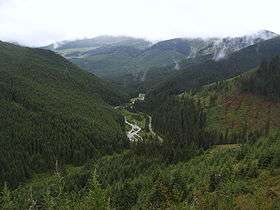 Prislop Pass, connecting Maramureș with Bukovina in northern Romania | |
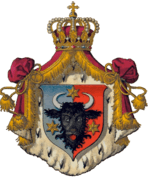 Coat of arms | |
| Nickname(s): "The Land of the Beech Trees" | |
 Location of Bukovina within northern Romania and neighbouring Ukraine | |
| Country | |
| Bukovina | 1774 |
| Founded by | Habsburg Monarchy |
| Largest cities | Chernivtsi Suceava |
| Demonym(s) | Bukovinian Bucovinean (in Romanian) |
| Time zone | UTC+2 (EET) |
| • Summer (DST) | UTC+3 (EEST) |
A region of Moldavia during the Middle Ages, the territory of what became known as Bukovina was, from 1774 to 1918, an administrative division of the Habsburg Monarchy, the Austrian Empire, and Austria-Hungary. After World War I, Romania established its control over Bukovina. In 1940, the northern half of Bukovina was annexed by the Soviet Union in violation of the Molotov–Ribbentrop Pact,[4] and currently is part of Ukraine.
Name

The name Bukovina came into official use in 1775 with the region's annexation from the Principality of Moldavia to the possessions of the Habsburg Monarchy, which became the Austrian Empire in 1804, and Austria-Hungary in 1867.
The official German name of the province under Austrian rule (1775–1918), die Bukowina, was derived from the Polish form Bukowina, which in turn was derived from the common Slavic form of buk, meaning beech tree (cf the Ukrainian бук [buk]; also the German Buche).[5][6] Another German name for the region, das Buchenland, is mostly used in poetry, and means "beech land", or "the land of beech trees". In Romanian, in literary or poetic contexts, the name Țara Fagilor ("the land of beech trees") is sometimes used. In English, an alternative form is The Bukovina, increasingly an archaism, which, however, is found in older literature.
In modern Ukraine, the name "Bukovina" is unofficial, but is common when referring to the Chernivtsi Oblast, as over two thirds of the oblast is the northern part of Bukovina. In Romania the term Northern Bukovina is sometimes synonymous with the entire Chernivtsi Oblast of Ukraine, while (Southern) Bukovina refers to the Suceava County of Romania (although 30% of the present-day Suceava County covers territory outside of the historical Bukovina).
History
Part of a series on the |
|---|
| History of Romania |
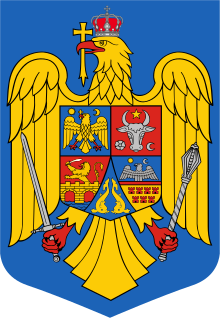 |
|
Post-Revolution |
|
|
The territory of Bukovina had been part of Moldavia since the 14th century. It was first delineated as a separate district in 1775, and was made a nominal duchy within the Austrian Empire in 1849.
Background
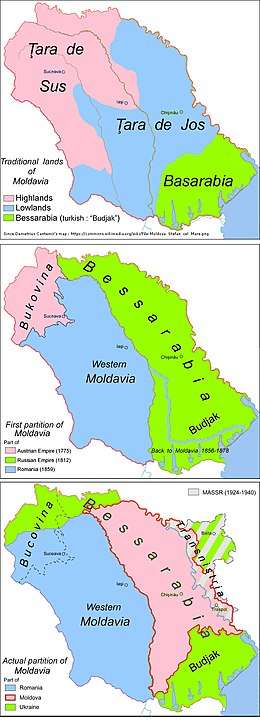
The Moldavian state had appeared by the mid-14th century, eventually expanding its territory all the way to the Black Sea. Bukovina and neighboring regions were the nucleus of the Moldavian Principality, with the city of Iasi as its capital from 1388 (after Baia and Siret). The name of Moldavia (Romanian: Moldova) is derived from a river (Moldova River) flowing in Bukovina.
In the 15th century, Pokuttya, the region immediately to the north, became the subject of disputes between the Principality of Moldavia and the Polish Kingdom. Pokuttya was inhabited by Ruthenians (the predecessors of modern Ukrainians and Rusyns) and Hutsuls; the latter also reside in western Bukovina. In 1497 a battle took place at the Cosmin Forest (the hilly forests separating Chernivtsi and Siret valleys), at which Stephen III of Moldavia (Stephen the Great), managed to defeat the much-stronger but demoralized army of King John I Albert of Poland. The battle is known in Polish popular culture as "the battle when the Knights have perished".
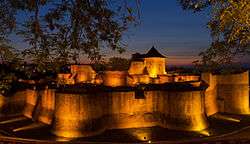
In this period, the patronage of Stephen the Great and his successors on the throne of Moldavia saw the construction of the famous painted monasteries of Moldoviţa, Suceviţa, Putna, Humor, Voroneţ, Dragomirna, Arbore and others. With their renowned exterior frescoes, these monasteries remain some of the greatest cultural treasures of Romania; some of them are World Heritage Sites, part of the painted churches of northern Moldavia.
In 1513, Moldavia started to pay annual tribute to the Ottoman Empire, but remained autonomous and was governed as before by a native Voivod (the medieval Eastern European equivalent of Prince). In May, 1600 Mihai Viteazul (Michael the Brave), became the ruler the two Romanian principalities and Transylvania.
For short periods of time (during wars), the Polish Kingdom occupied parts of northern Moldavia. However, the old border was re-established each time, as for example on 14 October 1703 the Polish delegate Martin Chometowski acknowledged "Between us and Wallachia (i.e. Moldavia) God himself set Dniester as the border" (Inter nos et Valachiam ipse Deus flumine Tyras dislimitavit).
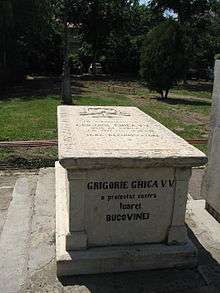
In the course of the Russo-Turkish War of 1768–1774, the Ottoman armies were defeated by the Russian Empire, which occupied the region during 15 December 1769–September 1774, and previously during 14 September–October 1769. Bukovina was the reward the Habsburgs received for aiding the Russians in that war. Prince Grigore III Ghica of Moldavia protested and was prepared to take action to recover the territory, but was assassinated, and a Greek-Phanariot foreigner was put on the throne of Moldavia by the Ottomans.
Austrian Empire
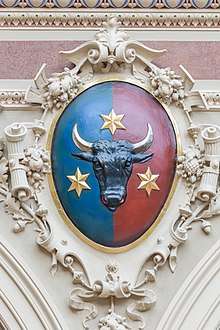
The Austrian Empire occupied Bukovina in October, 1774. Following the First Partition of Poland in 1772, the Austrians claimed that they needed it for a road between Galicia and Transylvania. Bukovina was formally annexed in January 1775. On 2 July 1776, at Palamutka, Austrians and Ottomans signed a border convention, Austria giving back 59 of the previously occupied villages, retaining 278 villages.
Bukovina was a closed military district (1775–1786), then the largest district, Kreis Czernowitz (after its capital Czernowitz) of the Austrian constituent Kingdom of Galicia and Lodomeria (1787–1849). On 4 March 1849, Bukovina became a separate Austrian Kronland 'crown land' under a Landespräsident (not a Statthalter, as in other crown lands) and was declared the Herzogtum Bukowina (a nominal duchy, as part of the official full style of the Austrian Emperors). In 1860 it was again amalgamated with Galicia, but reinstated as a separate province once again 26 February 1861, a status that would last until 1918.[7]
In 1849 Bukovina got a representative assembly, the Landtag (diet). The Moldavian nobility had traditionally formed the ruling class in that territory. In 1867, with the re-organisation of the Austrian Empire as the Austro-Hungarian Empire, it became part of the Cisleithanian or Austrian territories of Austria-Hungary, and remained so until 1918.
Late 19th to early 20th centuries

The 1871 and 1904 jubilees held at Putna Monastery, near the tomb of Ştefan cel Mare, have constituted tremendous moments for Romanian national identity in Bukovina. Since gaining its independence, Romania envisioned to incorporate this historic province which, as a core of the Moldavian Principality, was of a great historic significance to its history and contained many prominent monuments of its art and architecture.[8]
Despite the influx of migrants encouraged under the Austrian rule, Romanians continued to be the largest ethnic group in the province in the first part of the 19th century. However, according to the 1880 census, there were 239,690 Ruthenians and Hutzuls, or roughly 41.5% of the population of the region, while Romanians were second with 190,005 people or 33%, a ratio that remained more or less the same until World War I. Ruthenians is an archaic name for Ukrainians, while the Hutsuls are a regional Ukrainian subgroup.
Under Austrian rule Bukovina remained ethnically mixed: predominantly Romanians in the south, Ukrainians (commonly referred to as Ruthenians in the Empire) in the north, with small numbers of Hungarian Székelys, Slovak, and Polish peasants, and Germans, Poles and Jews in the towns. The 1910 census counted 800,198 people, of which: Ruthenians 38.88%, Romanians 34.38%, Germans 21.24% (Jews 12.86% included), Polish people 4.55%, Hungarian people 1.31%, Slovaks 0.08%, Slovenes 0.02%, Italian people 0.02%, and a few Croats, Romani people, Serbs and Turkish people. Romanians were still present in all settlements of the region, but their number decreased in the northern villages. Many of Bukovina's Germans and Jews, as well as a number of Romanians and Hungarians, emigrated in 19th and 20th century to North America.[9][10][11]
In 1783, by an Imperial Decree of Joseph II, local Eastern Orthodox Eparchy of Bukovina (with its seat in Czernowitz) was placed under spiritual jurisdiction of the Metropolitanate of Karlovci.[12] Some friction appeared in time between the church hierarchy and the Romanians, complaining that Old Church Slavonic was favored to Romanian, and that family names were being slavicized. In spite of Romanian-Slav frictions over the influence in the local church hierarchy, there was no Romanian-Ukrainian inter-ethnic tension, and both cultures developed in educational and public life. After the rise of Romanian nationalism in 1848, Habsburg authorities awarded additional rights to Ukrainians in an attempt to temper Romanian ambitions of independence.[13] At the end of the 19th century, the development of Ukrainian culture in Bukovina surpassed Galicia and the rest of Ukraine with a network of Ukrainian educational facilities, while Dalmatia formed an Archbishopric, later raised to the rank of Metropolitanate.
In 1873, the Eastern Orthodox Bishop of Czernowitz (who was since 1783 under the spiritual jurisdiction of the Metropolitan of Karlovci) was elevated to the rank of Archbishop, when a new Metropolitanate of Bukovinian and Dalmatia was created. The new Archbishop of Czernowitz gained supreme jurisdiction over Serbian eparchies of Dalmatia and Kotor, which were also (until then) under spiritual jurisdiction of Karlovci.
In the early 20th century, a group of scholars surrounding the Austrian Archduke Franz Ferdinand created a plan (that never came to pass) of United States of Greater Austria. The specific proposal was published in Aurel C. Popovici's book “Die Vereinigten Staaten von Groß-Österreich“ [The United States of Greater Austria], Leipzig, 1906. According to it, most of Bukovina (including Czernowitz) would form, with Transylvania, a Romanian state, while the north-western portion (Zastavna, Kozman, Waschkoutz, Wiznitz, Gura Putilei, and Seletin districts) would form with the bigger part of Galicia a Ukrainian state, both in a federation with 13 other states under the Austrian crown.[14][15]
Kingdom of Romania
| Romanian takeover of Bukovina | |||||||||
|---|---|---|---|---|---|---|---|---|---|
| Part of the Polish–Ukrainian War | |||||||||
| |||||||||
| Belligerents | |||||||||
|
|
| ||||||||
| Commanders and leaders | |||||||||
|
|
| ||||||||
In World War I, several battles were fought in Bukovina between the Austro-Hungarian, German, and Russian armies, which resulted in the Russian army being driven out in 1917.
With the collapse of Austria-Hungary in 1918, both the local Romanian National Council and the Ukrainian National Council based in Galicia claimed the region. A Constituent Assembly on 14/27 October 1918 formed an Executive Committee, to whom the Austrian governor of the province handed power. After an official request by Iancu Flondor, Romanian troops swiftly moved in to take over the territory, against Ukrainian protest.[16] Although local Ukrainians attempted to incorporate parts of northern Bukovina into the short-lived West Ukrainian People's Republic, this attempt was defeated by Polish and Romanian troops.
Under the protection of Romanian troops, the Romanian Council summoned a General Congress of Bukovina for 15/28 November 1918, where 74 Romanians, 13 Ruthenians, 7 Germans, and 6 Poles were represented (this is the linguistic composition, and Jews were not recorded as a separate group). According to Romanian historiography, popular enthusiasm swept the whole region, and a large number of people gathered in the city to wait for the resolution of the Congress.[17][18]
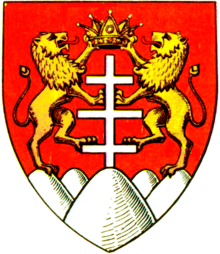
The Congress elected the Romanian Bukovinian politician Iancu Flondor as chairman, and voted for the union with the Kingdom of Romania, with the support of the Romanian, German, and Polish representatives; the Ukrainians did not support this.[19] The reasons stated were that, until its takeover by the Habsburg in 1775, Bukovina was the heart of the Principality of Moldavia, where the gropniţele domneşti (voivods' burial sites) are located, and dreptul de liberă hotărâre de sine (right of self-determination).[20] Romanian control of the province was recognized internationally in the Treaty of St. Germain in 1919.
During the interwar period, Romanian authorities oversaw a programme of Romanianization aiming its assimilationist policies at the Ukrainian population of the region. The Romanian language was introduced into ethnic minority schools in 1923, and, by 1926, all public Ukrainian schools in Bukovina were closed (private schools were still allowed to exist).[19]
At the same time, Ukrainian enrollment at the Cernăuţi University fell from 239 out of 1671, in 1914, to 155 out of 3,247, in 1933, while simultaneously Romanian enrollment there increased several times to 2,117 out of 3,247.[21] In part this was due to attempts to switch to Romanian as the primary language of university instruction, but chiefly to the fact that the university was one of only five in Romania, and was considered prestigious.
In the decade following 1928, as Romania tried to improve its relations with the Soviet Union, Ukrainian culture was given some limited means to redevelop, though these gains were sharply reversed in 1938.
According to the 1930 Romanian census, Romanians made up 44.5% of the total population of Bukovina, and Ukrainians (including Hutsuls) 29.1%.[22] In the northern part of the region, however, Romanians made up only 32.6% of the population, with Ukrainians significantly outnumbering Romanians.
On August 14, 1938, Bukovina officially disappeared from the map, becoming a part of Ținutul Suceava, one of ten new administrative regions. At the same time, Cernăuți, the third most populous town in Romania (after Bucharest and Chișinău), which had been a mere county seat for the last 20 years, became again a (regional) capital. Also, Bukovinian regionalism continued under the new brand. During its first months of existence, Ținutul Suceava suffered far right (Iron Guard) uproars, to which the regional governor Gheorghe Alexianu (the future governor of Transnistria) reacted with nationalist and anti-Semitic measures. Alexianu was replaced by Gheorghe Flondor on February 1, 1939.
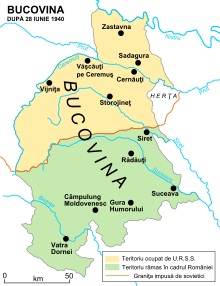
As a result of the Molotov–Ribbentrop Pact, the USSR demanded not only Bessarabia but also Northern Bukovina from Romania on June 26, 1940. (Bukovina bordered Eastern Galicia, which the USSR had annexed during the Invasion of Poland.) Initially, the USSR wanted the whole of Bukovina. Nazi Germany, which was surprised by the Soviet claim to Bukovina, invoked the German ethnics living in the region. As a result, the USSR only demanded the northern, overwhelmingly Ukrainian part, arguing that it was a "reparation for the great loss produced to the Soviet Union and Bassarabia's population by twenty-two years of Romanian domination of Bassarabia". Following the Soviet ultimatum, Romania ceded Northern Bukovina, which included Cernăuți, to the USSR on June 28, 1940. The withdrawal of the Romanian Army, authorities and civilians was disastrous. Mobs attacked retreating soldiers and civilians, whereas a retreating unit massacred Jewish soldiers and civilians in the town of Dorohoi. The Red Army occupied Cernăuți and Storojineț counties, as well as parts of Rădăuți and Dorohoi counties (the latter belonged to Ținutul Suceava, but not to Bukovina). The new Soviet-Romanian border was traced less than 20 kilometres (12 miles) north of Putna Monastery. Until September 22, 1940, when Ținutul Suceava was abolished, the spa town Vatra Dornei served as the capital of Ținutul Suceava.[23]
Second World War
In 1940, Chernivtsi Oblast (⅔ of which is Northern Bukovina) had a population of circa 805,000, out of which 47.5% were Ukrainians and 28.3% were Romanians, with Germans, Jews, Poles, Hungarians and Russians comprising the rest. The strong Ukrainian presence was the official motivation for inclusion of the region into the Ukrainian SSR and not into the newly formed Moldavian SSR. Whether the region would have been included in the Moldavian SSR, if the commission presiding over the division had been led by someone other than the Ukrainian communist leader Nikita Khrushchev, remains a matter of debate among scholars. In fact, some territories with a mostly Romanian population (e.g., Hertza region) were allotted to the Ukrainian SSR.
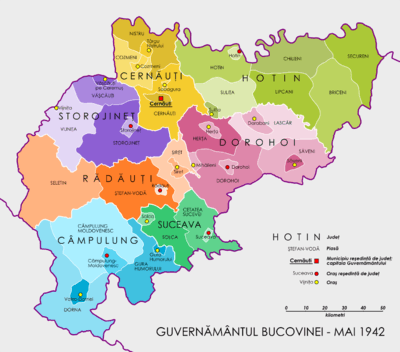
After the instauration of Soviet rule, under NKVD orders, thousands of local families were deported to Siberia during this period,[24] with 12,191 people targeted for deportation in a document dated 2 August 1940 (from all formerly Romanian regions included in the Ukrainian SSR),[24] while a December 1940 document listed 2,057 persons to be deported to Siberia.[25] The largest action took place on 13 June 1941, when about 13,000 people were deported to Siberia and Kazakhstan.[26] The majority of those targeted were ethnic local Romanians, but there were (to a lesser degree) representatives of other ethnicities, as well.[27]
Until the repatriation convention of 15 April 1941, NKVD troops killed hundreds of Romanian peasants of Northern Bukovina as they tried to cross the border into Romania in order to escape from Soviet authorities. This culminated on 1 April 1941 with the Fântâna Albă massacre.
Almost the entire German population of northern Bukovina was coerced to resettle in 1940–1941 to the parts of Poland then occupied by Nazi Germany, during 15 September 1940 – 15 November 1940, after this area was occupied by the Soviet Union. About 45,000 ethnic Germans had left Northern Bukovina by November 1940.[28]
In the course of the 1941 attack on the Soviet Union by the Axis forces, the Romanian Third Army led by General Petre Dumitrescu (operating in the north), and the Fourth Romanian Army (operating in the south) regained Northern Bukovina, as well as Hertza, and Bassarabia, during June–July 1941.
The Axis invasion of northern Bukovina was catastrophic for its Jewish population, as conquering Nazi soldiers immediately began massacring its Jewish residents. Surviving Jews were forced into ghettoes to await deportation to work camps in Transnistria where 57,000 had arrived by 1941. Bukovina's remaining Jews were spared from certain death when it was retaken by Soviet forces in February, 1944. In all, about half of Bukovina's entire Jewish population had perished. After the war and the return of the Soviets, most of the Jewish survivors from northern Bukovina fled to Romania (and later settled in Israel).[29]
After the war
Part of a series on the |
|---|
| History of Ukraine |
  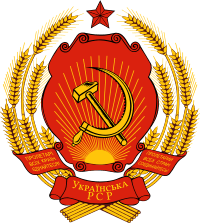 |
|
Early history
|
|
Modern history
|
|
Topics by history |
|
|


In 1944 the Red Army drove the Axis forces out and re-established Soviet control over the territory. Romania was forced to formally cede the northern part of Bukovina to the USSR by the 1947 Paris peace treaty. The territory became part of the Ukrainian SSR as Chernivtsi Oblast (province). After the war the Soviet government deported or killed about 41,000 Romanians.[30] As a result of killings and mass deportations, entire villages, mostly inhabited by Romanians, were abandoned (Albovat, Frunza, I.G.Duca, Buci—completely erased, Prisaca, Tanteni and Vicov—destroyed to a large extent).[31] Men of military age (and sometimes above) were conscripted into the Soviet Army. That did not protect them, however, from being arrested and deported for being "anti-Soviet elements".
As a reaction, partisan groups (composed of both Romanians and Ukrainians) began to operate against the Soviets in the woods around Chernivtsi, Crasna and Codrii Cosminului.[32] In Crasna (in the former Storozhynets county) villagers attacked Soviet soldiers who were sent to "temporarily resettle" them, since they feared deportation. This resulted in dead and wounded among the villagers, who had no firearms.
Spring 1945 saw the formation of transports of Polish repatriates who (voluntarily or by coercion) had decided to leave. Between March 1945 and July 1946, 10,490 inhabitants left northern Bukovina for Poland, including 8,140 Poles, 2,041 Jews and 309 of other nationalities.
Overall, between 1930 (last Romanian census) and 1959 (first Soviet census), the population of northern Bukovina decreased by 31,521 people. According to official data from those two censuses, the Romanian population had decreased by 75,752 people, and the Jewish population by 46,632, while the Ukrainian and Russian populations increased by 135,161 and 4,322 people, respectively.
After 1944, the human and economic connections between the northern (Soviet) and southern (Romanian) parts of Bukovina were severed. While the northern part is the nucleus of the Ukrainian Chernivtsi Oblast, the southern part is tightly integrated with the other Romanian historic regions.
In Romania, 28 November is a holiday observed as Bukovina Day.[33]
Geography
Bukovina proper has an area of 10,442 km2 (4,032 sq mi). The territory of Romanian (or Southern) Bukovina is located in northeastern Romania and it is part of the Suceava County (plus three localities in Botoșani County), whereas Ukrainian (or Northern) Bukovina is located in western Ukraine and it is part of the Chernivtsi Oblast.
Population
Historical population

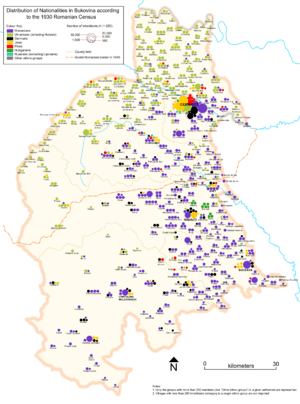
According to the 1775 Austrian census, the province had a total population of 86,000 (this included 56 villages which were later returned to Moldova). The census only recorded social status and some ethno-religious groups (Jews, Armenians, Gypsies, German colonists). In 1919, the historian Ion Nistor claimed that Romanians constituted an overwhelming majority in 1774, roughly 64,000 (85%) of the 75,000 total population. Meanwhile, about 8,000 (10%) were Ruthenians, and 3,000 (4%) other ethnic groups.[34] On the other hand, just four years before the same Nistor claimed the 1774 population consisted of 52,750 Romanians (73%), 15.000 Ruthenians (21%) and 4,000 others "using Romanian in conversation" (6%).[35] In 2011, an anthroponimical analysis of the Russian census of the population of Moldova in 1774 asserted a population of 68,700 people in 1774, out of which 40,920 (59.6%) Romanians, 22,810 Ruthenians and Hutsuls (33.2%), and 7.2% Jews, Roma, and Armenians.[36]
Based on the above anthroponimical estimate for 1774 as well as subsequent official censuses, the ethnic composition of Bukovina changed in the years after 1775 when the Austrian Empire occupied the region. The population of Bukovina increased steadily, primarily through immigration, which Austrian authorities encouraged in order to develop the economy.[37] As reported by Nistor, in 1781 the Austrian authorities had reported that Bukovina's rural population was composed mostly of immigrants, with only about 6,000 of the 23,000 recorded families being "truly Moldavian". In Nistor's view, this referred only to the Moldavian population native to the region, while the total population included significant number of Romanian immigrants from Moldavia and Transylvania. Another Austrian official report from 1783, referring to the villages between the Dniester and the Prut, indicated Ruthenian-speaking immigrants from Poland constituting a majority, with only a quarter of the population speaking Moldavian. The same report indicated that Moldavians constituted the majority in the area of Suceava.[38] H.F. Müller gives the 1840 population used for purposes of military conscription as 339,669.[39] According to Alecu Hurmuzaki, by 1848, 55% of the population was Romanian. At the same time, the Ukrainian population rose to 108,907 and the Jewish population surged from 526 in 1774, to 11,600 in 1848.[34]
In 1843 the Ruthenian language was recognized, along with the Romanian language, as 'the language of the people and of the Church in Bukovina'.[40]
During the 19th century the Austrian Empire policies encouraged the influx of many immigrants, primarily Ukrainians ("Ruthenes") from Galicia and Romanians from Hungary and Transylvania, as well as smaller numbers of Germans, Poles, Jews and Hungarians.[40] Official censuses in the Austrian Empire (later Austria-Hungary) did not record ethno-linguistic data until 1850–1851. The 1857 and 1869 censuses omitted ethnic or language-related questions. 'Familiar language spoken' was not recorded again until 1880.
The Austrian census of 1850–1851, which for the first time recorded data regarding languages spoken, shows 48.50% Romanians and 38.07% Ukrainians.[41] Subsequent Austrian censuses between 1880 and 1910 reveal a Romanian population stabilizing around 33% and a Ukrainian population around 40%.
According to the 1930 Romanian Census, Bukovina had a population of 853,009.[42] Romanians made up 44.5% of the population, while 27.7% were Ukrainians/Ruthenians (plus 1.5% Hutsuls), 10.8% Jews, 8.9% Germans, 3.6% Poles, and 3.0% others or undeclared.[43]
According to estimates and censuses data, the population of Bukovina was:
| Year | Romanians | Ukrainians | Others (most notably Germans, Jews, and Poles) | Total | |||
|---|---|---|---|---|---|---|---|
| 1774 (e)[34][36] | 40,920 – 64,000 | 59.6% - 85.33% | 8,000 – 22,810 | 10.6% - 33.2% | 3,000 – 4,970 | 4.0% - 7.2% | 51,920 – 91,780 |
| 1846 (c)[44] | 140,628 | 37.89% | 180,417 | 48.61% | N/A | 13.5% | 321,045 |
| 1848 (e)[34] | 209,293 | 55.4% | 108,907 | 28.8% | 59,381 | 15.8% | 377,581 |
| 1851 (c)[44][45] | 184,718 | 48.5% | 144,982 | 38.1% | 51,126 | 13.4% | 380,826 |
| 1880 (c)[46] | 190,005 | 33.4% | 239,960 | 42.2% | 138,758 | 24.4% | 568,723 |
| 1890 (c)[47] | 208,301 | 32.4% | 268,367 | 41.8% | 165,827 | 25.8% | 642,495 |
| 1900 (c)[48] | 229,018 | 31.4% | 297,798 | 40.8% | 203,379 | 27.8% | 730,195 |
| 1910 (c) | 273,254 | 34.1% | 305,101 | 38.4% | 216,574 | 27.2% | 794,929 |
| 1930 (c)[42][49] | 379,691 | 44.5% | 248,567 | 29.1% | 224,751 | 26.4% | 853,009 |
Note: e-estimate; c-census
Current population

The present demographic situation in Bukovina hardly resembles that of the Austrian Empire. The northern (Ukrainian) and southern (Romanian) parts became significantly dominated by their Ukrainian and Romanian majorities, respectively, with the representation of other ethnic groups being decreased significantly.
According to the data of the 2001 Ukrainian census,[50] the Ukrainians represent about 75% (689,100) of the population of Chernivtsi Oblast, which is the closest, although not an exact, approximation of the territory of the historic Northern Bukovina. The census also identified a fall in the Romanian and Moldovan populations to 12.5% (114,600) and 7.3% (67,200), respectively. Russians are the next largest ethnic group with 4.1%, while Poles, Belarusians, and Jews comprise the rest 1.2%. The languages of the population closely reflect the ethnic composition, with over 90% within each of the major ethnic groups declaring their national language as the mother tongue (Ukrainian, Romanian, and Russian, respectively).
The fact that Romanians and Moldovans were presented as separate categories in the census results, has been criticized by the Romanian Community of Ukraine – Interregional Union, which complains that this old Soviet-era practice, results in the Romanian population being undercounted, as being divided between Romanians and Moldovans.
The Romanians mostly inhabit the southern part of Chernivtsi region, being the majority in Hertsaivskyi Raion, while they form the majority with Moldovans in the Ukrainian plurality Hlybotskyi Raion. Moldovans are the majority in Novoselytsia Raion. In the other eight districts, and the city of Chernivtsi, Ukrainians are in the majority.
The southern, or Romanian Bukovina has a significant Romanian majority (94.8%), largest minority group being the Romani people (1.9%) and Ukrainians, who make up 0.9% of the population (2011 census). Other minor ethnic groups include Lipovans, Poles (in Cacica, Mănăstirea Humorului, Mușenița, Moara, and Păltinoasa), Zipser Germans (in Cârlibaba and Iacobeni) and Bukovina Germans in Suceava and Rădăuți, as well as Slovaks.
Cities and towns
Southern Bukovina
| Table highlighting all urban settlements in Southern Bukovina | |||
|---|---|---|---|
| Romanian name | German name | Ukrainian name | Population |
| Cajvana | Keschwana | Кажване, Kazhvane | 6,812 |
| Câmpulung Moldovenesc | Kimpolung | Кимпулунґ, Kympulung; historically Довгопілля, Dovhopillya | 16,105 |
| Frasin | Frassin | Фрасин, Frasyn | 5,702 |
| Gura Humorului | Gura Humorului | Ґура-Гумора, Gura-Humora | 12,729 |
| Milișăuți | Milleschoutz | Милишівці, Mylyshivtsi | 4,958 |
| Rădăuţi | Radautz | Радівці, Radivtsi | 22,145 |
| Siret | Sereth | Сирет, Syret | 7,721 |
| Solca | Solka | Солька, Sol'ka | 2,188 |
| Suceava | Sotschen/Sutschawa/Suczawa; historically in Old High German: Sedschopff | Сучава, Suchava; historic Сочава, Sochava | 124,161 |
| Vatra Dornei | Dorna-Watra | Ватра Дорни, Vatra Dorny | 13,659 |
| Vicovu de Sus | Ober Wikow | Верхнє Викове, Verkhnye Vykove | 13,053 |
Northern Bukovina
| Table highlighting all urban settlements in Northern Bukovina | |||
|---|---|---|---|
| Ukrainian name | Romanian name | German name | Population |
| Berehomet | Berehomete pe Siret | Berhometh | 7,717 |
| Boyany | Boian | Bojan | 4,425 |
| Chornivka | Cernăuca | Czernowka | 2,340 |
| Chernivtsi | Cernăuţi | Czernowitz | 266,366 |
| Hlyboka | Adâncata | Hliboka | 9,474 |
| Kitsman | Cozmeni | Kotzman | 6,287 |
| Krasnoyilsk | Crasna-Ilschi | Krasna | 10,163 |
| Luzhany | Lujeni | Luschany/Luzan | 4,744 |
| Mikhalcha | Mihalcea | Mihalcze | 2,245 |
| Nepolokivtsi | Nepolocăuţi/Grigore-Ghica Vodă | Nepolokoutz/Nepolokiwzi | 2,449 |
| Novoselytsia | Suliţa-Târg/Suliţa Nouă/Nouă Suliţi | Nowosielitza | 7,642 |
| Putyla | Putila | Putilla Storonetz/Putyla | 3,435 |
| Storozhynets | Storojineţ | Storozynetz | 14,197 |
| Vashkivtsi | Văşcăuţi | Waschkautz/Waschkiwzi | 5,415 |
| Voloka | Voloca pe Derelui | Woloka | 3,035 |
| Vyzhnytsia | Vijniţa | Wiznitz | 4,068 |
| Zastavna | Zastavna | Zastawna | 7,898 |
See also
Notes
References
- Valentina Glajar (1 January 2004). The German Legacy in East Central Europe as Recorded in Recent German-language Literature. Camden House. pp. 13–. ISBN 978-1-57113-256-7.
- edited by O. Derhachov (1996). Українська державність у ХХ столітті. (Ukrainian statehood of the twentieth century) (in Ukrainian). Politychna Dumka.CS1 maint: extra text: authors list (link)
- (original version, in German – use English and French versions with caution)
- WorldStatesmen (under Ukraine)
- Dumitru Covălciuc. Românii nord-bucovineni în exilul totalitarismului sovietic
- Victor Bârsan "Masacrul inocenţilor", Bucuresti, 1993, pp. 18–19
- Ştefan Purici. Represiunile sovietice... pp. 255–258;
- Vasile Ilica. Fântâna Albă: O mărturie de sânge (istorie, amintiri, mărturii). - Oradea: Editura Imprimeriei de Vest, 1999.
- Marian Olaru. Consideraţii preliminare despre demografie si geopolitica pe teritoriul Bucovinei. Analele Bucovinei. Tomul VIII. Partea I. Bucuresti: Editura Academiei Române, 2001
- Ţara fagilor: Almanah cultural-literar al românilor nord-bucovineni. Cernăuţi-Târgu-Mureş, 1994
- Aniţa Nandris-Cudla. Amintiri din viaţă. 20 de ani în Siberia. Humanitas, Bucharest, 2006 (second edition), (in Romanian) ISBN 973-50-1159-X
Further reading
- Jews of Bukovina on the Eve of the War (PDF). Secaucus, NJ: Miriam Weiner Routes to Roots Foundation. 1999. ISBN 978-0-9656508-0-9 – via Adapted by Dorcas Gelabert and Stephen Freeman.
External links
![]()
![]()
| Wikisource has the text of the 1911 Encyclopædia Britannica article Bukovina. |
![]()
- "Chernivtsi oblast (region) info page". Travel information on Ukrainian(Northern) Bukovina. Archived from the original on 2011-06-20.
- Ukrainian Census results (in English and Ukrainian)
- City of Chernivtsy (in Ukrainian)
- The Metropolitanate of Moldavia and Bucovina (Romanian Orthodox Church) (in Romanian)
- "Soviet Ultimatum Notes (University of Bucharest site)". Archived from the original on November 13, 2007. Retrieved December 30, 2005.
- "detailed article about WWII and aftermath". Archived from the original on 2007-11-13. Retrieved 2006-04-17.CS1 maint: BOT: original-url status unknown (link)
- http://jgaliciabukovina.net/
- Klaus Peter Berger, The Creeping Codification of the New Lex Mercatoria, Kluwer Law International, 2010, p. 132
- Steven Tötösy de Zepetnek (January 2002). Comparative Central European Culture. Purdue University Press. pp. 53–. ISBN 978-1-55753-240-4.
- "Bukovina | region, Europe". Encyclopedia Britannica. Retrieved 2018-12-10.
- Brackman, Roman The Secret File of Joseph Stalin: A Hidden Life (2001) p. 341
- "Bukovyna". Retrieved 20 January 2017.
- "Painted monasteries of Southern Bucovina – Brasov Travel Guide". Archived from the original on 6 September 2014. Retrieved 20 January 2017.
- Paul Robert Magocsi. A History of Ukraine. Toronto: University of Toronto Press (1996), p. 420 ISBN 0-8020-0830-5
- "Bukovina (region, Europe) – Britannica Online Encyclopedia". Britannica.com. Retrieved 2013-03-26.
- "Bukovina Society of the Americas Home Page". Bukovinasociety.org. Retrieved 2013-03-26.
- "Bukovina Germans". Freepages.genealogy.rootsweb.com. Retrieved 2013-03-26.
- "Bukovina Immigration to North America". Bukovinasociety.org. Archived from the original on 2012-06-09. Retrieved 2013-03-26.
- Archived May 9, 2005, at the Wayback Machine
- Irina Livezeanu, Cultural Politics in Greater Romania, Cornell University, 1995, p. 54-55.
- Archived October 22, 2007, at the Wayback Machine
- "Bukovina Society". Retrieved 20 January 2017.
- Bukovyna, Encyclopedia of Ukraine
- Constantin Kiriţescu (1989). Istoria războiului pentru întregirea României: 1916–1919. Ed. Științifică și Enciclopedică. ISBN 978-973-29-0048-2.
- Ion Bulei, Scurta istorie a românilor, Editura Meronia, Bucuresti, 1996, pp. 104-107
- Minoritatea ucraineana din Romania (1918–1940) Archived 2015-10-17 at the Wayback Machine
- "Congresul general al Bucovinei, intrupand suprema putere a tarii si fiind investiti cu puterea legiuitoare, in numele suveranitatii nationale, hotaram: Unirea neconditionata si pe vecie a Bucovinei in vechile ei hotare pana la Ceremuş, Colacin si Nistru cu Regatul Romaniei". The General Congress of Bukovina, embodying the supreme power of the country [Bukovina], and invested with legislative power, in the name of national sovereignty, we decide: Unconditional and eternal union of Bukovina, in its old boundaries up to Ceremuş [river], Colachin and Dniester [river] with the Kingdom of Romania.
- A. Zhukovsky, Chernivtsi University, Encyclopedia of Ukraine, 2001, Canadian Institute of Ukrainian Studies. Accessed 11 February 2006.
- Irina Livezeanu. Cultural Politics in Greater Romania: Regionalism, Nation Building, and Ethnic Struggle, 1918–1930. Cornell University Press. 2000. p. 53.
- Philippe Henri Blasen: Suceava Region, Upper Land, Greater Bukovina or just Bukovina? Carol II’s Administrative Reform in North-Eastern Romania (1938-1940), in: Anuarul Institutului de Istorie „A. D. Xenopol”, supplement, 2015;
Philippe Henri Blasen: Terrorisme légionnaire et ordonnances antisémites. La Région Suceava d’octobre 1938 à septembre 1940, in: Archiva Moldaviae 2018.
Philippe Henri Blasen: Regionalism after the Administrative Reform of 14th August 1938. How Romanian Authorities and Elites Celebrated the Year 1918 in Suceava Region, in: Anuarul Institutului de Istorie „A. D. Xenopol”, 2018. - "Archived copy". Archived from the original on 2007-10-06. Retrieved 2006-04-17.CS1 maint: archived copy as title (link)
- "Calvarul bucovinenilor sub ocupatia sovietica: ZIUA". Retrieved 20 January 2017.
- "UNHCR Moldova". Unhcr.md. Archived from the original on 2006-06-28. Retrieved 2013-03-26.
- "Radio Romania International - The Genocide of Romanians in Northern Bukovina". Radio Romania International.
- Leonid Ryaboshapko. Pravove stanovishche natsionalnyh menshyn v Ukraini (1917–2000), P. 259 (in Ukrainian).
- http://www.yadvashem.org/odot_pdf/Microsoft%20Word%20-%206091.pdf
- "Observatorul". Observatorul. Retrieved 2013-03-26.
- Ţara fagilor: Almanah cultural-literar al românilor nord-bucovineni. Cernăuţi-Târgu-Mureş, 1994, p. 160.
- Dragoş Tochiţă. Români de pe Valea Siretului de Sus, jertfe ale ocupaţiei nordului Bucovinei şi terorii bolşevice. - Suceava, 1999. - P. 35. (in Romanian)
- Președintele Iohannis a promulgat legea prin care data de 28 noiembrie este declarată Ziua Bucovinei (in Romanian)
- Keith Hitchins. The Romanians 1774–1866. Oxford: Clarendon Press (1996), pp. 226
- Nistor, Ion (1915). Românii și rutenii în Bucovina. Bucharest: Romanian Academy. pp. 70–72.
- Ungureanu, Constantin (2011). "Die Bevölkerung der Bukowina (von Besetzung im Jahr 1774 bis zur Revolution 1848)". Romanian Journal of Population Studies (in German). pp. 117–143.
- Raimund Friedrich Kaindl. Das Ansiedlungswesen in der Bukowina seit der Besitzergreifung durch Österreich. Innsbruck (1902), pp. 1-71
- Nistor, Ion (1915). Românii și rutenii în Bucovina. Bucharest: Romanian Academy. pp. 107–112.
- Müller, H F (1848). Die Bukowina im Königreiche Galizien (in German). Wien: H.F. Müller's Kunsthandlung. p. 9. Retrieved 2014-06-05.
- Bukovina Handbook, prepared under the Direction of the Historical Section of the British Foreign Office No.6. Published in London, Feb.1919.
- 1855 Austrian ethnic-map showing census data in lower right corner
- Irina Livezeanu (2000). Cultural Politics in Greater Romania: Regionalism, Nation Building & Ethnic Struggle, 1918–1930. Cornell University Press. pp. 52–. ISBN 0-8014-8688-2.
- "1930 Romanian Census".
- Ionas Aurelian Rus (2008), Variables Affecting Nation-building: The Impact of the Ethnic Basis, the Educational System, Industrialization and Sudden Shocks. ProQuest. ISBN 9781109059632. p. 102
- 1855 Austrian ethnic-map showing 1851 census data in lower right corner File:Ethnographic map of austrian monarchy czoernig 1855.jpg
- First Austro-Hungarian census measuring the 'language spoken at home' of the population
- Austro-Hungarian census of 1890
- Austro-Hungarian census of 1900
- Jan Owsinski, Piotr Eberhardt. Ethnic Groups and Population Changes in Twentieth-Century Central-Eastern Europe. M.E. Sharpe. pp. 295–. ISBN 978-0-7656-1833-7.
- "All-Ukrainian population census|". Ukrcensus.gov.ua. Retrieved 2013-03-26.
